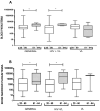The Parasitemia has Contributed to the Severity of Cases of Visceral Leishmaniasis
- PMID: 39011003
- PMCID: PMC11246353
- DOI: 10.1007/s12088-023-01182-6
The Parasitemia has Contributed to the Severity of Cases of Visceral Leishmaniasis
Abstract
Visceral leishmaniasis (VL) occurs due to the evolution, virulence, and adaptation of Leishmania, vector biology, host immune system evasion, and reservoir hosts. Parasitemia can be involved as a warning regarding the clinical severity of VL The present study aims to evaluate the relationship between parasitemia and the prognosis of individuals with VL. Blood and bone marrow samples from individuals with VL were analyzed to identify parasite and quantify or measure parasite burden. Individuals were classified in the clinical score model of risk of death by disease proposed by Coura-Vital et al. (PLoS Negl Trop Dis 8(12): e33742014, 2014). 39/74 individuals presented a better prognosis, and 35/74 individuals presented a worse prognosis. HIV + VL co-infection was present in 32 individuals, of which 12 were considered severe. The group aged 51 to 64 was classified as severe, with a decrease in leukocytes (p-value 0.0295) and neutrophils (p-value 0.0476). L. infantum DNA was identified in blood and bone marrow, in 69 individuals, and not detected in 5 individuals. The quantification of the parasite showed greater parasitemia in bone marrow (P = 0.0003) with an average of 4.70 × 104 Leishmanias/mL about blood, with 0.29 × 104 Leishmanias/mL. Individuals in the age group aged 51 to 64 co-infected with HIV + VL had higher parasitemia (p-value 0.0150) with 2.44 × 104 Leishmanias/mL in blood and bone marrow than in the group aged 20 to 50. Parasitemia, measured by molecular biology in blood and bone marrow, was related to the worst clinical prognosis of VL in the age group aged 51 to 64.
Keywords: Clinical prognosis; Parasitemia; Severity of illness; Visceral leishmaniasis.
© Association of Microbiologists of India 2024. Springer Nature or its licensor (e.g. a society or other partner) holds exclusive rights to this article under a publishing agreement with the author(s) or other rightsholder(s); author self-archiving of the accepted manuscript version of this article is solely governed by the terms of such publishing agreement and applicable law.
Conflict of interest statement
Conflict of interestThe authors declare that they have no known competing financial interests or personal relationships that could have appeared to influence the work reported in this paper.
Figures



References
-
- WHO . Status of endemicity of visceral leishmaniasis worldwide. WHO; 2021.
-
- Al-Fakhar SA, Ali WM, Obaid KY, Mohammed KIA, Ali SHM, Mousa JM. Association of circulating immune complexes in the development of visceral leishmianisis. Res J Pharm Technol. 2020;13(7):3284. doi: 10.5958/0974-360X.2020.00582.X. - DOI
-
- Fialho Junior L, Fonseca da Pires S, Burchmore R, McGill S, Weidt S, Ruiz JC, et al. Proteomic analysis reveals differentially abundant proteins probably involved in the virulence of amastigote and promastigote forms of Leishmania infantum. Parasitol Res. 2021;120(2):679–692. doi: 10.1007/s00436-020-07020-8. - DOI - PubMed
-
- Araujo Soares MR, Lopes Antunes JE, de Mendonça IL, Lima RN, Nery Costa CH. Occurrence of Lutzomyia longipalpis Lutz & Neiva 1912 and Cerdocyon thous Linnaeus 1977, in a visceral leishmaniasis endemic area in Brazil. Acta Trop. 2017;174:118–121. doi: 10.1016/j.actatropica.2017.06.021. - DOI - PubMed
LinkOut - more resources
Full Text Sources
